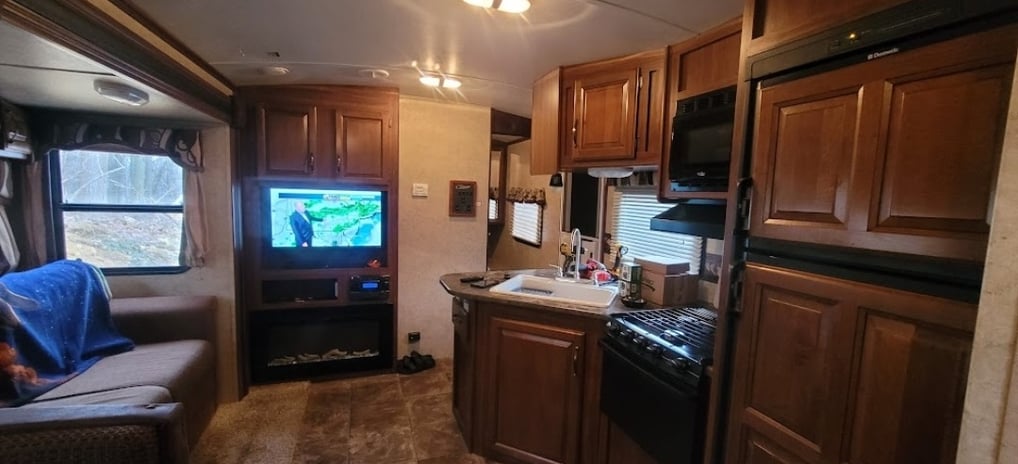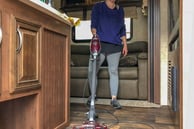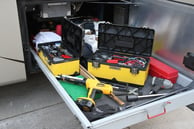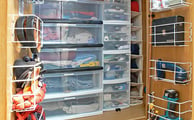Maintaining & Inspecting Your RVs Interior
Owning an RV opens up a world of adventure, but it also comes with the responsibility of keeping it in top shape. While many focus on the exterior and mechanical parts, the interior deserves just as much attention. Here are five essential tips for maintaining and inspecting your RV's interior to ensure it remains a cozy and comfortable home on wheels.
On-The-Go Mobile RV Repair
11/14/202410 min read


Understanding the Importance of Regular Interior Inspections
Regular interior inspections of your RV are crucial for ensuring its safety and longevity. An RV is more than just a mode of transportation; it’s a home on wheels for a lot of people. Our RVs need the same care and attention as any house. Skipping routine inspections can lead to a lot of problems, such as mold growth, pest infestations, and serious structural damage. These issues can compromise your safety and health while spending time in your RV, making it essential to do regular inspections and maintenance to ensure a worry-free adventure.
Mold growth is a particularly concerning issue that can arise from hidden moisture in areas such as the bathroom, kitchen, or under the sink. Without regular inspections, these damp spots might go unnoticed, creating an environment conducive to mold growth, which can lead to respiratory problems and allergic reactions. A lot of campers and lifers have found that using a DampRid product or Dehumidifier helps get a lot of the dampness out of the RV.
Additionally, pest infestations, such as rodents or insects, can establish themselves in your RV if regular inspections do not take place. These pests not only cause damage to the structure and furnishings but can also pose health risks through contamination.
Routine interior inspections allow you to identify and address small issues before they escalate into costly repairs. Issues such as leaks, cracks, or worn-out components. These issues can be spotted early through routine checks, saving you from extensive repair bills and potential downtime for your RV. This regular upkeep not only protects your investment but also enhances the overall enjoyment of RV life. A well-maintained interior contributes to comfort, cleanliness, and a pleasant atmosphere during your stays.
In conclusion, understanding the importance of regular interior inspections ultimately safeguards both your RV and your camping experience. By committing to routine checks, you can ensure that your home on wheels remains safe, comfortable, and enjoyable for years to come.
Creating a Comprehensive Inspection Checklist
Maintaining a recreational vehicle (RV) involves regular inspections, particularly of its interior components, to ensure both safety and comfort during travels. To facilitate this process, developing a comprehensive inspection checklist tailored to your RV's specific needs is essential. This checklist serves as a practical tool for identifying areas that require attention, repairs, or upgrades.
Begin by establishing key areas to assess during your inspections. A primary concern should be checking for leaks around windows, doors, and plumbing fixtures. Water damage can lead to significant problems if not addressed promptly, so be thorough in examining walls, ceilings, and floors for any signs of moisture or mold. Additionally, evaluate the state of your RV’s appliances. Ensure that the refrigerator, oven, and heater are functioning correctly, as these systems are crucial for providing basic comforts while on the road.
Next, turn your attention to the cabinetry. Inspect cabinet doors and drawers for signs of wear and tear, such as loose hinges or damaged surfaces. Proper functioning prevents items from becoming dislodged during travel, thus enriching the overall experience. Assessing the condition of furniture is also vital; check for stability and any signs of wear that could affect usability. Be particularly observant of upholstery and cushions for stains or damage that detracts from both the aesthetics and comfort of the space.
Prioritizing tasks on your checklist is crucial for efficient inspections. Categorize issues by severity and frequency of use, allowing you to address the most pressing concerns first. Regular updates to this list, paired with consistent inspections, will contribute to the longevity and functionality of your RV's interior, enhancing your overall travel experience. By diligently following the created checklist, you can better ensure your RV remains a safe and enjoyable home away from home.
Utilizing Professional Maintenance Services
When it comes to maintaining your RV's interior, engaging professional maintenance services can offer significant advantages. These experts possess the expertise and experience necessary to identify issues that may be overlooked by inexperienced owners. One of the primary benefits of hiring a qualified inspector is their comprehensive knowledge of RV components from the plumbing to electrical systems. Their inspections often include checks for water damage, mold, and wear and tear, ensuring that every aspect of your RV's interior is in optimal condition.
It is essential to look for professionals with proper accreditation and positive reviews. A qualified inspector should be licensed and ideally have experience specifically with RVs. Look for certifications from recognized organizations within the RV industry as they demonstrate a commitment to quality. Furthermore, inquire about their experience with the particular RV model you own, as this can significantly impact the quality of their assessment.
Professional services typically offer a range of maintenance options, from routine checks to comprehensive overhauls. During a professional interior inspection, service providers often utilize specialized tools to examine hidden areas such as under the cabinetry or behind appliances. This meticulous approach allows them to uncover potential problems early, preventing costly repairs down the line.
Although DIY maintenance is valuable, integrating professional checks into your routine can greatly enhance the longevity of your RV's interior. Regular assessments can provide peace of mind, knowing that a trained eye has thoroughly evaluated the condition of your vehicle. Additionally, they can offer tailored advice on how to maintain the interior effectively between services.
To find reliable service providers, seek recommendations from fellow RV enthusiasts, or utilize online platforms dedicated to RV maintenance. Understanding their inspection process and the specific services offered will help you make an informed decision, ensuring your RV remains in excellent shape for many enjoyable journeys ahead.
Tips for DIY Maintenance and Repairs
Owning an RV provides unique opportunities for travel and adventure, but it also requires a commitment to maintaining and inspecting its interior. Many RV owners may wish to tackle minor repairs and maintenance on their own, which can be both cost-effective and rewarding. To assist in this endeavor, here are a few practical tips for performing DIY maintenance and repairs on your RV’s interior.
First and foremost, it's essential to gather the necessary tools and materials for basic repairs. A well-stocked toolkit should include a screwdriver set, pliers, a utility knife, a measuring tape, a caulking gun, and assorted screws and adhesives. Additionally, make sure you have cleaning supplies, such as multi-surface cleaner, microfiber cloths, and a vacuum, at hand to keep your RV’s interior in top condition. Before beginning any project, assess the area you will be working on to ensure you have everything you need to complete the job efficiently.
Next, familiarizing yourself with common problems can help you easily troubleshoot issues as they arise. For example, leaks can often develop around windows or doors, and replacing old caulk is usually a straightforward fix. When re-sealing windows, clean the surfaces thoroughly before applying new caulk, ensuring a tight seal to prevent moisture intrusion. Similarly, if any plumbing issues are detected, such as leaks or slow drains, inspect the connections and consider using Teflon tape for a better seal on threaded joints.
As a safety precaution, always wear protective gear such as gloves and safety glasses while handling tools and materials. Additionally, ensure that your workspace is well-ventilated, particularly when working with adhesives or caulk, as fumes can be hazardous. By following these tips, RV owners can confidently manage their interior upkeep, turning small problems into manageable tasks and preserving the integrity of their vehicle for years to come.
Seasonal Considerations for RV Interior Care
Maintaining the interior of your RV requires a keen awareness of seasonal changes, as these variations can significantly impact the condition of your vehicle's interior. Each season introduces specific challenges that necessitate tailored maintenance routines to ensure an optimal living environment.
During the humid months, moisture control becomes paramount. Excess humidity can lead to mold and mildew growth, which can damage upholstery and other interior materials. To combat this, RV owners should invest in dehumidifiers and regularly check for leaks or signs of dampness. It is advisable to keep windows slightly open when parked to allow for air circulation, which can help reduce moisture buildup. Regular cleaning and drying of surfaces prone to humidity can further prevent potential damage.
As winter approaches, RV winterization is crucial. This process includes insulating pipes to prevent freezing, draining water lines, and adding antifreeze to plumbing systems. Additionally, removing any food items that could spoil or attract pests during the colder months is essential. Properly storing your RV in a climate-controlled environment, if possible, will also shield its interior from extreme temperature fluctuations.
In contrast, summer presents its own set of challenges, particularly with heat damage. Prolonged exposure to high temperatures can lead to fading, warping, or cracking of furnishings and surfaces. To protect your RV interior during the hot months, consider using reflective window coverings to block direct sunlight and park in shaded areas whenever feasible. It can also be beneficial to conduct regular inspections of storage compartments and interior materials to catch any damage early.
Creating a seasonal checklist can simplify the process of maintaining your RV's interior. By identifying specific tasks for each season, such as moisture checks in spring, winterization preparations in fall, and heat protection strategies in summer, RV owners can ensure a proactive approach to care. Such systematic planning not only preserves the longevity of your RV's interior but also enhances your overall camping experience.
Keeping Your RV Organized for Easy Maintenance Access
Maintaining an organized RV interior is crucial for facilitating easy inspections and ensuring that necessary maintenance can be conducted efficiently. An organized space not only enhances the overall living environment but also significantly simplifies the process of accessing maintenance tools and supplies when needed. To achieve this, it is vital to embrace a decluttering approach, which involves regularly assessing the items you have and determining which ones are essential for your travels.
One effective method for decluttering is the "one in, one out" rule; for every new item introduced to your RV, consider removing an existing one. This practice helps prevent accumulation of unnecessary belongings that can complicate organization. Additionally, consider applying seasonal checks; for instance, at the end of your travels, you can evaluate whether the items you packed for the season are still required for your next journey. This will help streamline your possessions and keep only what is truly necessary.
Storage solutions play a vital role in maintaining an orderly RV. Utilizing multi-functional furniture that can double as storage is an excellent way to maximize available space. Furthermore, investing in storage containers and organizers can significantly improve organization. Clearly labeling these storage containers allows you to identify the contents quickly, which is particularly useful during inspections or when obtaining maintenance supplies.
In summary, an organized RV interior enhances both comfort and practical accessibility. By focusing on decluttering, implementing effective storage solutions, and labeling areas within your RV, you will find that conducting inspections and accessing essential maintenance tools becomes a much more streamlined process. This proactive approach not only contributes to the longevity of your vehicle but also elevates your overall travel experience.
Documenting Your RV Maintenance History
Maintaining a detailed record of your RV's inspections and maintenance activities is crucial for several reasons. The documentation aids in identifying patterns related to your RV's performances, which can help you notice any potential issues. By having a comprehensive history of repairs and inspections, you will be better equipped to understand your RV's unique needs, allowing you to schedule maintenance accordingly and avoid unexpected breakdowns. This proactive approach not only ensures your RV remains in optimal condition but also enhances your overall travel experience.
It is also very helpful for the RV techs and inspectors. These make it easier for them to identify and address any potential issues that may arise more efficiently.
Maintaining a documented history supports your RV's resale value. Potential buyers often seek assurance of the vehicle's care and reliability before committing to a purchase. A well-organized maintenance log that details every repair, inspection, and upgrade can serve as a testament to your diligence as an owner. This transparency not only fosters buyer confidence but also justifies a higher selling price, ultimately benefiting your investment in the long term.
When it comes to documenting maintenance processes, it's important to capture key information in your logs. Essential entries should include the date of service, the type of maintenance performed (such as oil changes, tire rotations, or appliance checks), any parts replaced, and notes on the condition of various systems. Photos of significant repairs or upgrades can also enhance your records and provide visual proof of your RV's maintenance status.
To facilitate convenient and efficient tracking, consider utilizing digital tools. Many RV enthusiasts opt for mobile apps or online spreadsheets tailored for documenting maintenance history. These platforms typically provide user-friendly interfaces, automated reminders for upcoming tasks, and even data analysis features that allow you to identify trends in your RV's service needs. Employing these tools can simplify your tracking efforts and ultimately contribute to the longevity and performance of your RV.


"Morning coffee: because adulting is hard, and caffeine is the only thing keeping my brain from staging a rebellion!"


"Cleaning the interior of an RV: because finding last year's snacks is only fun until you realize they’ve evolved into a new species!"


Having RV tools handy is essential for ensuring you're prepared for any roadside emergencies or maintenance needs.


"At the campground, each season brings its own charm"


"Keeping your RV organized not only simplifies your travels but also makes maintenance a breeze"


"RV paperwork: the only thing longer than your road trip itinerary and twice as confusing—at least the snacks don't require a signature!"

